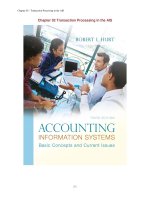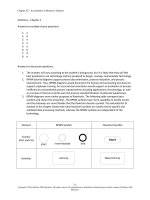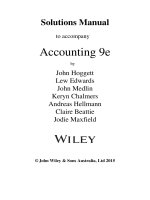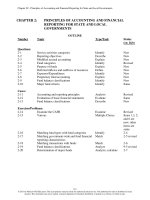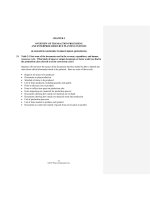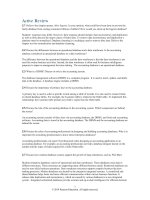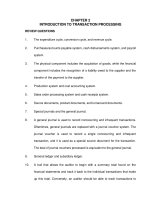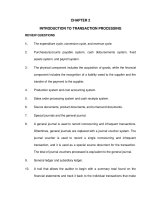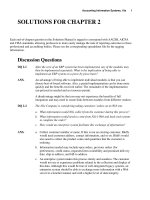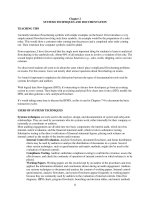Test bank and solution of accounting principles 12e john (2)
Bạn đang xem bản rút gọn của tài liệu. Xem và tải ngay bản đầy đủ của tài liệu tại đây (852.61 KB, 115 trang )
CHAPTER 2
LEARNING OBJECTIVES
1. DESCRIBE HOW ACCOUNTS, DEBITS, AND CREDITS
ARE USED TO RECORD BUSINESS TRANSACTIONS.
2. INDICATE HOW A JOURNAL IS USED IN THE
RECORDING PROCESS.
3. EXPLAIN HOW A LEDGER AND POSTING HELP IN
THE RECORDING PROCESS.
4. PREPARE A TRIAL BALANCE.
Copyright © 2015 John Wiley & Sons, Inc.
Weygandt, Accounting Principles, 12/e, Instructor’s Manual
(For Instructor Use Only)
2-1
CHAPTER REVIEW
The Account
1.
(L.O. 1) An account is an individual accounting record of increases and decreases in a specific
asset, liability, or owner’s equity item.
2.
In its simplest form, an account consists of (a) the title of the account, (b) a left or debit side, and
(c) a right or credit side. The alignment of these parts resembles the letter T, and therefore the
account form is called a T-account.
Debits and Credits
3.
The terms debit and credit mean left and right, respectively.
a. The act of entering an amount on the left side of an account is called debiting the account
and making an entry on the right side is crediting the account.
b. When the debit amounts exceed the credits, an account has a debit balance; when the
reverse is true, the account has a credit balance.
4.
In a double-entry system, equal debits and credits are made in the accounts for each transaction.
Thus, the total debits will always equal the total credits.
5.
The effects of debits and credits on assets and liabilities and the normal balances are:
Accounts
Assets
Liabilities
Debits
Increase
Decrease
Credits
Decrease
Increase
Normal Balance
Debit
Credit
6.
Accounts are kept for each of the four subdivisions of owner’s equity: capital, drawings, revenues,
and expenses.
7.
The effects of debits and credits on the owner’s equity accounts and the normal balances are:
Accounts
Owner’s Capital
Owner’s Drawings
Revenues
Expenses
8.
Debits
Decrease
Increase
Decrease
Increase
Credits
Increase
Decrease
Increase
Decrease
Normal Balance
Credit
Debit
Credit
Debit
The expanded accounting equation is:
Assets = Liabilities + Owner’s Capital – Owner’s Drawings + Revenues – Expenses
The Journal
9.
(L.O. 2) The basic steps in the recording process are:
a. Analyze each transaction for its effect on the accounts.
b. Enter the transaction information in a journal.
c. Transfer the journal information to the appropriate accounts in the ledger.
Copyright © 2015 John Wiley & Sons, Inc.
Weygandt, Accounting Principles, 12/e, Instructor’s Manual
(For Instructor Use Only)
2-2
10.
Transactions are initially recorded in a journal.
a. A journal is referred to as a book of original entry.
b. A general journal is the most basic form of journal.
11.
The journal makes several significant contributions to the recording process:
a. It discloses in one place the complete effect of a transaction.
b. It provides a chronological record of transactions.
c. It helps to prevent or locate errors because the debit and credit amounts for each entry can
be easily compared.
12.
Entering transaction data in the journal is known as journalizing. When three or more accounts
are required in one journal entry, the entry is known as a compound entry.
The Ledger
13.
(L.O. 3) The ledger is the entire group of accounts maintained by a company. It keeps in one
place all the information about changes in account balances and it is a source of useful data for
management.
14.
The standard form of a ledger account has three columns and the balance in the account is
determined after each transaction.
15.
Posting is the procedure of transferring journal entries to the ledger accounts. The following steps
are used in posting:
a. In the ledger, enter in the appropriate columns of the account(s) debited the date, journal
page, and debit amount.
b. In the reference column of the journal, write the account number to which the debit amount
was posted.
c. Perform the same steps in a. and b. for the credit amount.
The Chart of Accounts
16.
A chart of accounts is a listing of the accounts and the account numbers which identify their
location in the ledger. The numbering system usually starts with the balance sheet accounts and
follows with the income statement accounts.
Copyright © 2015 John Wiley & Sons, Inc.
Weygandt, Accounting Principles, 12/e, Instructor’s Manual
(For Instructor Use Only)
2-3
The Basic Steps
17.
The basic steps in the recording process are illustrated as follows:
Transaction
On September 4, Fesmire Inc. pays $3,000 cash to a creditor in full payment of
the balance due.
Basic analysis
The liability Accounts Payable is decreased $3,000, and the asset Cash is
decreased $3,000.
Debit-credit
analysis
Debits decrease liabilities: debit Accounts Payable $3,000.
Credits decrease assets: credit Cash $3,000.
The Trial Balance
18.
(L.O. 4) A trial balance is a list of accounts and their balances at a given time. The trial balance
proves the mathematical equality of debits and credits after posting.
19.
A trial balance does not prove that the company has recorded all transactions or that the ledger is
correct because the trial balance may balance even when
a. a transaction is not journalized.
b. a correct journal entry is not posted.
c. a journal entry is posted twice.
d. incorrect accounts are used in journalizing or posting.
e. offsetting errors are made in recording the amount of a transaction.
Copyright © 2015 John Wiley & Sons, Inc.
Weygandt, Accounting Principles, 12/e, Instructor’s Manual
(For Instructor Use Only)
2-4
LECTURE OUTLINE
A.
The Account.
An account is an individual accounting record of increases and decreases in
a specific asset, liability, or owner’s equity item.
An account consists of three parts:
1. A title.
2. A left or debit side.
3. A right or credit side.
B.
Debits and Credits.
The terms debit and credit are directional signals: Debit indicates left, and credit
indicates right.
1. Assets, drawings, and expenses are increased by debits and decreased
by credits.
2. Liabilities, owner’s capital, and revenues are increased by credits and
decreased by debits.
C.
Steps in the Recording Process.
There are three basic steps in the recording process:
1. Analyze each transaction for its effects on the accounts.
2. Enter the transaction information in a journal.
Copyright © 2015 John Wiley & Sons, Inc.
Weygandt, Accounting Principles, 12/e, Instructor’s Manual
(For Instructor Use Only)
2-5
3. Transfer the journal information to the appropriate accounts in the ledger.
D.
The General Journal/Journalizing.
Entering transaction data in the general journal is called journalizing.
The general journal:
1. Discloses in one place the complete effects of a transaction.
2. Provides a chronological record of transactions.
3. Helps to prevent or locate errors because the debit and credit amounts
for each entry can be easily compared.
4. A simple journal entry involves only two accounts (one debit and one credit)
whereas a compound journal entry involves three or more accounts.
E.
The Ledger.
The ledger is the entire group of accounts maintained by a company. A general ledger contains all the assets, liabilities, and owner’s equity accounts.
1. The ledger provides the balance in each of the accounts as well as
keeps track of changes in these balances.
2. Companies arrange the ledger in the sequence in which they present
the accounts in the financial statements, beginning with the balance sheet
accounts.
F.
Posting/Chart of Accounts.
1. Posting is transferring journal entries to the ledger accounts.
2. Posting involves the following steps:
Copyright © 2015 John Wiley & Sons, Inc.
Weygandt, Accounting Principles, 12/e, Instructor’s Manual
(For Instructor Use Only)
2-6
a.
In the ledger, in the appropriate columns of the account(s) debited,
enter the date, journal page, and debit amount shown in the journal.
b.
In the reference column of the journal, write the account number to
which the debit amount was posted.
c.
In the ledger, in the appropriate columns of the account(s) credited,
enter the date, journal page, and credit amount shown in the journal.
d.
In the reference column of the journal, write the account number to
which the credit amount was posted.
3. A chart of accounts lists the accounts and the account numbers that
identify their location in the ledger. Accounts are usually numbered starting
with the balance sheet accounts followed by income statement accounts.
G.
Trial Balance.
A trial balance is a list of accounts and their balances at a given time.
1. It proves the mathematical equity of debits and credits after posting.
2. It may also uncover errors in journalizing and posting.
3. It is useful the preparation of financial statements.
Copyright © 2015 John Wiley & Sons, Inc.
Weygandt, Accounting Principles, 12/e, Instructor’s Manual
(For Instructor Use Only)
2-7
INVESTOR INSIGHT
Bank regulators fined Bank One Corporation (Now Chase) $1.8 million because
they felt the reliability of the bank’s accounting system caused it to violate
regulatory requirements. The financial records of Waste Management Inc. were
in such disarray that 10,000 employees were receiving pay slips that were in
error.
In order for these companies to prepare and issue financial statements, their
accounting equations must have been in balance at year-end. How could these
errors or misstatements have occurred?
Answer: A company’s accounting equation (its books) can be in balance yet its
financial statements have errors or misstatements because of the
following: entire transactions were not recorded, transactions were
recorded at wrong amounts; transactions were recorded in the wrong
accounts; transactions were recorded in the wrong accounting period.
Audits of financial statements uncover some, but not all, errors or
misstatements.
Copyright © 2015 John Wiley & Sons, Inc.
Weygandt, Accounting Principles, 12/e, Instructor’s Manual
(For Instructor Use Only)
2-8
IFRS
A Look At IFRS
International companies use the same set of procedures and records to keep track of
transaction data. Thus, the material in Chapter 2 dealing with the account, general rules
of debit and credit, and steps in the recording process—the journal, ledger, and chart of
accounts—is the same under both GAAP and IFRS.
KEY POINTS
Following are the key similarities and differences between GAAP and IFRS as related to the
recording process:
Transaction analysis is the same under IFRS and GAAP.
Both the IASB and FASB go beyond the basic definitions provided in the textbook for
the key elements of financial statements, that is, assets, liabilities, equity, revenue, and
expenses.
A trial balance under IFRS follows the same format as shown in the textbook.
As shown in the textbook, dollar signs are typically used only in the trial balance and the
financial statements. The same practice is followed under IFRS, using the currency of
the country where the reporting company is headquartered.
A trial balance under IFRS follows the same format as shown in the textbook.
IFRS relies less on historical cost and more on fair value than do FASB standards.
Internal controls are a system of checks and balances designed to prevent and detect
fraud and errors. While most public U. S. companies have these systems in place, many
non-U.S. companies have never completely documented the controls nor had an
independent auditor attest to their effectiveness.
LOOKING TO THE FUTURE
The basic recording process shown in this textbook is followed by companies across the globe.
It is unlikely to change in the future. The definitional structure of assets, liabilities, equity,
revenues, and expenses may change over time as the IASB and FASB evaluate their overall
conceptual framework for establishing accounting standards.
Copyright © 2015 John Wiley & Sons, Inc.
Weygandt, Accounting Principles, 12/e, Instructor’s Manual
(For Instructor Use Only)
2-9
20 MINUTE QUIZ
Circle the correct answer.
True/False
1.
Assets are increased by debits and liabilities are decreased by credits.
True
2.
The owner’s capital account is increased by credits.
True
3.
False
When the columns of the trial balance equal each other, it proves no errors occurred in
recording and posting.
True
10.
False
In posting, one should enter “J2” in the Post. Ref. Column on page two of the journal.
True
9.
False
Assets = liabilities + owner’s capital – drawings + revenues – expenses is a correct form
of the expanded basic accounting equation.
True
8.
False
Transferring journal entries to the ledger accounts is called posting and should be performed in chronological order.
True
7.
False
The basic steps in the recording process are (1) to analyze each transaction, (2) to enter
the transaction in a journal, and (3) to transfer the journal entry to the appropriate ledger
accounts.
True
6.
False
The ledger is the entire group of accounts maintained by a company.
True
5.
False
An account will have a credit balance if the total debit amounts exceed the total credit
amounts.
True
4.
False
False
The double-entry system helps ensure the accuracy of the recorded amounts and helps to
detect errors.
True
False
Copyright © 2015 John Wiley & Sons, Inc.
Weygandt, Accounting Principles, 12/e, Instructor’s Manual
(For Instructor Use Only)
2-10
Multiple Choice
1.
Transactions are initially recorded in the
a. general ledger.
b. general journal.
c. trial balance.
d. balance sheet.
2.
The right side of an account is referred to as the
a. footing.
b. chart side.
c. debit side.
d. credit side.
3.
A purchase of equipment for cash requires a credit to
a. Equipment.
b. Cash.
c. Accounts Payable.
d. Owner’s Capital.
4.
The equality of the accounting equation can be proven by preparing a
a. trial balance.
b. journal.
c. general ledger.
d. T-account.
5.
Which of the following accounts would be increased with a debit?
a. Rent Payable
b. Owner’s Capital
c. Service Revenue
d. Owner’s Drawings
Copyright © 2015 John Wiley & Sons, Inc.
Weygandt, Accounting Principles, 12/e, Instructor’s Manual
(For Instructor Use Only)
2-11
ANSWERS TO QUIZ
True/False
1.
2.
3.
4.
5.
False
True
False
True
True
6.
7.
8.
9.
10.
True
True
False
False
True
Multiple Choice
1.
2.
3.
4.
5.
b.
d.
b.
a.
d.
Copyright © 2015 John Wiley & Sons, Inc.
Weygandt, Accounting Principles, 12/e, Instructor’s Manual
(For Instructor Use Only)
2-12
CHAPTER 2
SOLUTIONS TO PROBLEMS: SET B
PROBLEM 2-1B
Date
Apr. 1
4
8
11
Account Titles and Explanation
Cash .......................................................
Owner’s Capital .............................
(Owner’s investment of cash
in business)
Ref.
Debit
35,000
35,000
Land .......................................................
Cash ...............................................
(Purchased land for cash)
27,000
Advertising Expense .............................
Accounts Payable .........................
(Incurred advertising
expense on account)
1,800
Salaries and Wages Expense ...............
Cash ...............................................
(Paid salaries)
1,500
27,000
1,800
1,500
12
No entry—Not a transaction.
13
Prepaid Insurance .................................
Cash ...............................................
(Paid for one-year
insurance policy)
1,650
Owner’s Drawings .................................
Cash ...............................................
(Withdrew cash for personal
use)
1,000
Cash .......................................................
Service Revenue............................
(Received cash for services
performed)
6,800
17
20
Copyright © 2015 John Wiley & Sons, Inc.
J1
Credit
1,650
1,000
6,800
Weygandt, Accounting Principles, 12/e, Problems: Set B Solutions (For Instructor Use Only)
2-1
PROBLEM 2-1B (Continued)
Date
Account Titles and Explanation
Apr. 25
Cash ......................................................
Unearned Service Revenue .............
(Received cash for future
services)
2,500
Cash ......................................................
Service Revenue............................
(Received cash for services
performed)
8,900
Accounts Payable.................................
Cash ...............................................
(Paid creditor on account)
900
30
30
Ref.
Debit
Credit
2,500
8,900
900
Copyright © 2015 John Wiley & Sons, Inc. Weygandt, Accounting Principles, 12/e, Problems: Set B Solutions (For Instructor Use Only)
2-2
PROBLEM 2-2B
(a)
Date
Account Titles and Explanation
Ref.
Debit
May 1
Cash .......................................................
Owner’s Capital .............................
(Owner’s investment of cash
in business)
101
301
20,000
20,000
2
No entry—not a transaction.
3
Supplies .................................................
Accounts Payable .........................
(Purchased supplies on
account)
126
201
2,500
Rent Expense ........................................
Cash ...............................................
(Paid office rent)
729
101
900
Accounts Receivable ............................
Service Revenue............................
(Billed client for services
performed)
112
400
3,200
Cash .......................................................
Unearned Service Revenue ..........
(Received cash for future
services)
101
209
3,500
Cash .......................................................
Service Revenue............................
(Received cash for services
performed)
101
400
1,200
Salaries and Wages Expense ...............
Cash ...............................................
(Paid salaries)
726
101
2,000
7
11
12
17
31
Copyright © 2015 John Wiley & Sons, Inc.
J1
Credit
2,500
900
3,200
3,500
1,200
2,000
Weygandt, Accounting Principles, 12/e, Problems: Set B Solutions (For Instructor Use Only)
2-3
PROBLEM 2-2B (Continued)
Date
Account Titles and Explanation
Ref.
May 31
Accounts Payable ($2,500 X 60%) ..........
Cash ..............................................
(Paid creditor on account)
201
101
Debit
Credit
1,500
1,500
(b)
Cash
Date
May 1
7
12
17
31
31
Explanation
Accounts Receivable
Date
Explanation
May 11
Supplies
Date
Explanation
May 3
Accounts Payable
Date
Explanation
May 3
31
Unearned Service Revenue
Date
Explanation
May 12
Ref.
J1
J1
J1
J1
J1
J1
Ref.
J1
Ref.
J1
Ref.
J1
J1
Ref.
J1
Debit
20,000
Credit
900
3,500
1,200
2,000
1,500
Debit
3,200
Debit
2,500
Debit
Credit
No. 112
Balance
3,200
Credit
No. 126
Balance
2,500
Credit
2,500
No. 201
Balance
2,500
1,000
1,500
Debit
No. 101
Balance
20,000
19,100
22,600
23,800
21,800
20,300
Credit
3,500
No. 209
Balance
3,500
Copyright © 2015 John Wiley & Sons, Inc. Weygandt, Accounting Principles, 12/e, Problems: Set B Solutions (For Instructor Use Only)
2-4
PROBLEM 2-2B (Continued)
Owner’s Capital
Date
Explanation
May 1
Ref.
J1
Service Revenue
Date
Explanation
May11
17
Ref.
J1
J1
Salaries and Wages Expense
Date
Explanation
May 31
Rent Expense
Date
Explanation
May 7
(c)
Ref.
J1
Ref.
J1
Debit
Debit
Debit
2,000
Debit
900
Credit
20,000
No. 301
Balance
20,000
Credit
3,200
1,200
No. 400
Balance
3,200
4,400
Credit
No. 726
Balance
2,000
Credit
No. 729
Balance
900
IRIS BECK, CPA
Trial Balance
May 31, 2017
Debit
Cash..................................................................... $20,300
Accounts Receivable..........................................
3,200
Supplies ..............................................................
2,500
Accounts Payable...............................................
Unearned Service Revenue................................
Owner’s Capital ..................................................
Service Revenue .................................................
Salaries and Wages Expense ............................
2,000
Rent Expense......................................................
900
$28,900
Copyright © 2015 John Wiley & Sons, Inc.
Credit
$ 1,000
3,500
20,000
4,400
$28,900
Weygandt, Accounting Principles, 12/e, Problems: Set B Solutions (For Instructor Use Only)
2-5
PROBLEM 2-3B
(a) & (c)
Balance
(4)
6)
Cash
8,000
(1)
(3)
14,000
(5)
6,000
(7)
(8)
3,500
Owner’s Capital
Balance
1,000
2,000
15,000
3,500
3,000
(8)
Balance
(2)
Supplies
13,000
4,200
Balance
Balance
(1)
(3)
Miscellaneous Expense
2,000
2,000
(5)
Salaries and Wages Expense
(7)
3,500
3,500
Equipment
20,000
20,000
Accounts Payable
Balance
(2)
15,000
15,000
15,000
Advertising Expense
1,000
1,000
17,200
Prepaid Rent
3,000
3,000
Owner’s Drawings
3,000
3,000
Service Revenue
(7)
Accounts Receivable
Balance
15,000
(4)
14,000
(7)
9,000
10,000
40,000
40,000
19,000
4,200
8,200
Copyright © 2015 John Wiley & Sons, Inc. Weygandt, Accounting Principles, 12/e, Problems: Set B Solutions (For Instructor Use Only)
2-6
PROBLEM 2-3B (Continued)
(b)
Trans.
1.
2.
3.
4.
5.
6.
7.
8.
Account Titles and Explanation
Debit
Advertising Expense..............................
Cash ...............................................
1,000
Supplies ..................................................
Accounts Payable .........................
4,200
Miscellaneous Expense .........................
Cash ...............................................
2,000
Cash ........................................................
Accounts Receivable ....................
14,000
Accounts Payable ..................................
Cash ...............................................
15,000
Cash ........................................................
Accounts Receivable .............................
Service Revenue ...........................
6,000
9,000
Salaries and Wages Expense ................
Cash ...............................................
3,500
Owner’s Drawings ..................................
Cash ...............................................
3,000
Credit
1,000
4,200
2,000
14,000
15,000
15,000
3,500
3,000
Copyright © 2015 John Wiley & Sons, Inc. Weygandt, Accounting Principles, 12/e, Problems: Set B Solutions (For Instructor Use Only)
2-7
PROBLEM 2-3B (Continued)
(d)
VIAN REPAIR SERVICE
Trial Balance
January 31, 2017
Cash....................................................................
Accounts Receivable.........................................
Supplies..............................................................
Prepaid Rent.......................................................
Equipment ..........................................................
Accounts Payable ..............................................
Owner’s Capital..................................................
Owner’s Drawings..............................................
Service Revenue ................................................
Advertising Expense .........................................
Miscellaneous Expense.....................................
Salaries and Wages Expense............................
Debit
$ 3,500
10,000
17,200
3,000
20,000
Credit
$ 8,200
40,000
3,000
15,000
1,000
2,000
3,500
$63,200
$63,200
Copyright © 2015 John Wiley & Sons, Inc. Weygandt, Accounting Principles, 12/e, Problems: Set B Solutions (For Instructor Use Only)
2-8
PROBLEM 2-4B
SEAN DEVINE COMPANY
Trial Balance
May 31, 2014
Cash ($5,850 + $520 – $486) ........................................
Accounts Receivable ($2,570 – $210) .........................
Prepaid Insurance ($700 + $100) .................................
Supplies ($0 + $520) .....................................................
Equipment ($8,000 – $520)...........................................
Accounts Payable ($4,500 – $100 + $520 – $210).......
Unearned Service Revenue .........................................
Owner’s Capital ($11,700 + $1,000) .............................
Owner’s Drawings ($0 + $1,000)..................................
Service Revenue ..........................................................
Salaries and Wages Expense ($4,200 + $200) ............
Advertising Expense ($1,100 + $486)..........................
Utilities Expense ($890 + $100) ...................................
Debit
$ 5,884
2,360
800
520
7,480
Credit
$ 4,710
650
12,700
1,000
6,960
4,400
1,586
990
$25,020
$25,020
Copyright © 2015 John Wiley & Sons, Inc. Weygandt, Accounting Principles, 12/e, Problems: Set B Solutions (For Instructor Use Only)
2-9
PROBLEM 2-5B
(a) & (c)
Cash
Date
Apr. 1
2
9
10
12
25
29
30
30
Explanation
Balance
J1
J1
J1
J1
J1
J1
J1
J1
Accounts Receivable
Date
Explanation
Apr. 30
Prepaid Rent
Date
Explanation
Apr. 30
Land
Date
Apr. 1
Ref.
Explanation
Balance
Buildings
Date
Explanation
Apr. 1
Balance
Ref.
J1
Ref.
J1
Ref.
Ref.
Debit
Credit
1,100
2,800
3,000
500
5,200
2,000
85
1,200
Debit
85
Debit
1,200
Debit
Debit
No. 101
Balance
4,000
2,900
5,700
2,700
2,200
7,400
5,400
5,485
4,285
Credit
No. 112
Balance
85
Credit
No. 136
Balance
1,200
Credit
No. 140
Balance
10,000
Credit
No. 145
Balance
8,000
Copyright © 2015 John Wiley & Sons, Inc. Weygandt, Accounting Principles, 12/e, Problems: Set B Solutions (For Instructor Use Only)
2-10
PROBLEM 2-5B (Continued)
Equipment
Date
Explanation
Apr. 1
Balance
Accounts Payable
Date
Explanation
Apr. 1
Balance
10
20
Mortgage Payable
Date
Explanation
Apr. 1
Balance
10
Owner’s Capital
Date
Explanation
Apr. 1
Balance
Service Revenue
Date
Explanation
Apr. 9
25
Rent Revenue
Date
Explanation
Apr. 30
Ref.
Debit
Ref.
Debit
J1
J1
1,000
Debit
J1
2,000
Ref.
J1
J1
Ref.
J1
Credit
1,000
Ref.
Ref.
Credit
Debit
Debit
Debit
Credit
Credit
No. 157
Balance
6,000
No. 201
Balance
2,000
1,000
2,000
No. 275
Balance
8,000
6,000
No. 301
Balance
18,000
Credit
2,800
5,200
No. 400
Balance
2,800
8,000
Credit
170
No. 429
Balance
170
Copyright © 2015 John Wiley & Sons, Inc. Weygandt, Accounting Principles, 12/e, Problems: Set B Solutions (For Instructor Use Only) 2-11
PROBLEM 2-5B (Continued)
Advertising Expense
Date
Explanation
Apr. 12
Salaries and Wages Expense
Date
Explanation
Apr. 29
Rent Expense
Date
Explanation
Apr. 2
20
Ref.
J1
Ref.
J1
Ref.
J1
J1
Debit
500
Debit
2,000
Debit
1,100
1,000
Credit
No. 610
Balance
500
Credit
No. 726
Balance
2,000
Credit
No. 729
Balance
1,100
2,100
(b)
Date
Apr. 2
Account Titles and Explanation
Rent Expense .....................................
Cash...........................................
(Paid film rental)
Ref.
729
101
Debit
1,100
1,100
3
No entry—not a transaction.
9
Cash....................................................
Service Revenue .......................
(Received cash for services
performed)
101
400
2,800
Mortgage Payable ..............................
Accounts Payable..............................
Cash...........................................
(Made payments on
mortgage and accounts
payable)
275
201
101
2,000
1,000
10
J1
Credit
2,800
3,000
Copyright © 2015 John Wiley & Sons, Inc. Weygandt, Accounting Principles, 12/e, Problems: Set B Solutions (For Instructor Use Only)
2-12
PROBLEM 2-5B (Continued)
Date
Account Titles and Explanation
Apr. 11
No entry—not a transaction.
12
20
25
29
30
30
Ref.
Debit
Advertising Expense.............................
Cash ..............................................
(Paid advertising expenses)
610
101
500
Rent Expense ........................................
Accounts Payable ........................
(Rented film on account)
729
201
1,000
Cash .......................................................
Service Revenue...........................
(Received cash for services
performed)
101
400
5,200
Salaries and Wages Expense ...............
Cash ..............................................
(Paid salaries expense)
726
101
2,000
Cash .......................................................
Accounts Receivable ............................
Rent Revenue ...............................
(17% X $1,000)
(Received cash and
balance on account for
rent revenue)
101
112
429
85
85
Prepaid Rent ..........................................
Cash ..............................................
(Paid cash for future film
rentals)
136
101
1,200
Credit
500
1,000
5,200
2,000
170
1,200
Copyright © 2015 John Wiley & Sons, Inc. Weygandt, Accounting Principles, 12/e, Problems: Set B Solutions (For Instructor Use Only) 2-13
